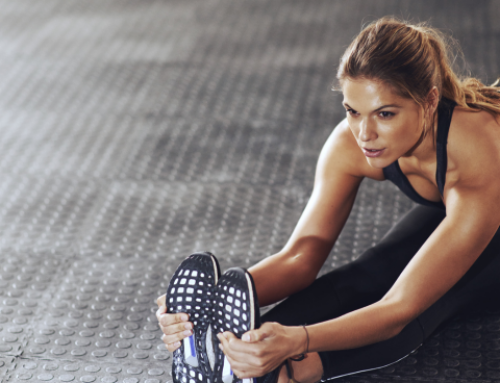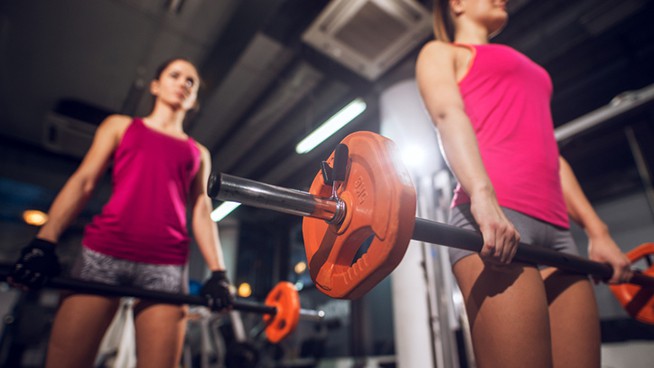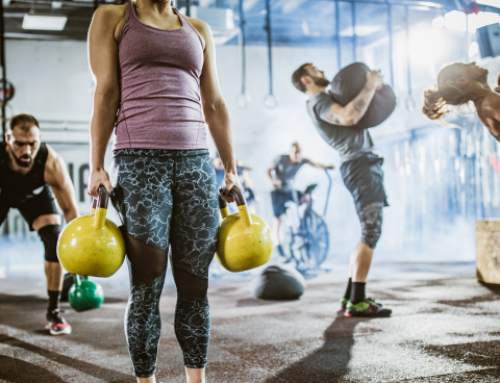5 Simple, Scientifically Proven Ways To Get Better Workouts
Crushing a workout is one of the best feelings a person can have.
You leave the gym or weight room soaked with sweat, satisfied you put forth an awesome effort and got better because of it. That’s the high that great athletes and dedicated gym rats get hooked on.
But how can you make that euphoric feeling more common? How can you cut down on the days where you drag through your workout and increase the days where you feel all but unstoppable?
Of course, the obvious factors—regularly getting enough sleep, having a consistently good diet, etc.—will help. But you already knew that. However, there are also some simpler ways to power up your workout that have been similarly backed by science. Utilize one of these tricks the next time you hit the gym, or combine several of them when you really want to demolish a workout.
1. Train With Tunes
For many gym-goers, this is already second nature. Earbuds are as essential to their workout as a pair of sneakers, as they can’t image training without tunes. But for those of you who work out without music, perhaps you should reconsider. Music can have a robust effect on athletic performance, as it’s been found capable of boosting everything from aerobic endurance to vertical jump height.
“Music is like a legal drug for athletes,” Dr. Costas Karageorghis, Deputy Head of Research at London’s Brunel University, told the American Council on Exercise. “It can reduce the perception of effort significantly and increase endurance by as much as 15 percent.” It can also make working out much more fun, as a 2016 study found that participants new to high-intensity interval workouts found the regimen to be more enjoyable when listening to music.
Generally speaking, the higher the beats per minute of the music you’re listening to, the more intensely you’ll find yourself working out (though the benefit seems to max out at songs around 145 bpm). Listening to your own tunes may be even more beneficial than just throwing on a random playlist, too—a 2017 study found that self-selected music resulted in both better performance on the Wingate test and more repetitions on the Bench Press.
2. Find a Workout Buddy to Give You a Boost
If you can find a training partner who’s motivated and in great shape, it can do wonders for your workouts—even if you’re only able to get together once a week or so. Natural competition is an incredibly strong motivator.
Having one or more workout partners who you perceive as “better” (faster, stronger, more endurance, etc.) than yourself is a time-tested way to boost performance. It’s an example of the Köhler effect, which is defined as a “phenomenon that occurs when a person works harder as a member of a group than when working alone.” One study found that pairing participants with virtual partners who had higher fitness levels than themselves led them to cycle for nearly twice as long as they would have had they been working out alone. That’s an impressive improvement, demonstrating how powerful an effect an good partner can be.
Additionally, working out with a partner will give you a constant spotter, allowing you to confidently attempt heavier lifts. However, not just anyone can be a suitable workout partner. If your partner is constantly late to the gym or more concerned with taking selfies than spotting you, he or she will probably not be a great partner.
3. Get Vocal
Many gym-goers are essentially mute during their workouts, slaving away in silence. But did you know that getting vocal—more specifically, grunting or yelling—can seriously improve your performance?
It’s true. A 2014 study found that “vocalized exhalation” (a.k.a. “grunting”) resulted in 25% greater handgrip force compared to passive breathing and 11% greater handgrip force compared to forced exhalation. A 2015 study found that yelling during a Broad Jump test helped participants jump an average of five percent further. A 2014 study found that grunting helped both male and female Division-I tennis players increase ball velocity without increasing oxygen cost nor rate of perceived exertion. It’s believed that grunting’s ability to enhance athletic performance may relate to increased core stiffness. “When you grunt or yell, the muscles around your rib cage contract,” M. Brennan Harris, an associate professor of kinesiology at the College of William and Mary, told OutsideOnline.com. “That contraction makes your core rigid—it stabilizes your trunk. And when your trunk is stable, your body can transfer more power to your limbs.”
This doesn’t necessarily mean you need to grunt your way through every rep of your workout, but don’t be afraid to get vocal when a particular exercise requires that little something extra.
4. Cater to Your Chronotype
Timing your training to your body’s natural circadian rhythms can have a big effect on your performance. More specifically, you should look to train at a time that most meshes with your “chronotype,” defined as one’s “natural inclination with regard to the times of day when they prefer to sleep or when they are most alert or energetic.” Being a “night owl” or an “early bird” isn’t just a phrase, it’s real and backed by science. The majority of the population are “N-types,” meaning they’re somewhere between a morning person and an evening person. These people can expect their best workouts in the late afternoon/early evening, between about 3:30 p.m. and 6 p.m. For the average person, this is when metrics such as body temperature, torque, anaerobic power, lung function and flexibility peak.
But morning types (M-types) have been found to perform best in the morning, due to their unique circadian rhythms. A 2017 systemic review published in the journal Sports Medicine found that “M-types perceived less effort when performing a sub-maximal physical task in the morning than did N-types and E-types (evening types). In addition, M-types generally showed better athletic performances, as measured by race times, in the morning than did N-types and E-types.” Want to know your chronotype? The New York Times created a great questionnaire for that exact purpose.
5. Have a Cup of Joe Before You Go
Caffeine is one of the most well-researched performance-enhancing substances in existence. Better yet, it’s totally legal. One of the best natural sources of caffeine? Coffee. Downing a cup of joe shortly before your workout can turbocharge your training, regardless of what type of exercise you’ll be undertaking.
Pre-workout caffeine ingestion has been associated with increases in muscular endurance, aerobic endurance, Bench Press performance, Squat performance, 1,500-meter run performance, intermittent-sprint performance, reaction time and more.
Peak blood levels of caffeine occur roughly 45-60 minutes after ingestion, and its effects can usually be felt for 4-6 hours after ingestion. While coffee can be an incredibly potent workout booster, it’s important to remember that all coffee is not created equal. While black coffee is healthy, Pumpkin Spice Lattes are not.
Read More: Bobex-73/iStock, GeorgeHanf/iStock, Tatomm/iStock, Ozimician/iStock, Antonio_Diaz/Thinkstock
READ MORE:
RECOMMENDED FOR YOU
MOST POPULAR
5 Simple, Scientifically Proven Ways To Get Better Workouts
Crushing a workout is one of the best feelings a person can have.
You leave the gym or weight room soaked with sweat, satisfied you put forth an awesome effort and got better because of it. That’s the high that great athletes and dedicated gym rats get hooked on.
But how can you make that euphoric feeling more common? How can you cut down on the days where you drag through your workout and increase the days where you feel all but unstoppable?
Of course, the obvious factors—regularly getting enough sleep, having a consistently good diet, etc.—will help. But you already knew that. However, there are also some simpler ways to power up your workout that have been similarly backed by science. Utilize one of these tricks the next time you hit the gym, or combine several of them when you really want to demolish a workout.
1. Train With Tunes
For many gym-goers, this is already second nature. Earbuds are as essential to their workout as a pair of sneakers, as they can’t image training without tunes. But for those of you who work out without music, perhaps you should reconsider. Music can have a robust effect on athletic performance, as it’s been found capable of boosting everything from aerobic endurance to vertical jump height.
“Music is like a legal drug for athletes,” Dr. Costas Karageorghis, Deputy Head of Research at London’s Brunel University, told the American Council on Exercise. “It can reduce the perception of effort significantly and increase endurance by as much as 15 percent.” It can also make working out much more fun, as a 2016 study found that participants new to high-intensity interval workouts found the regimen to be more enjoyable when listening to music.
Generally speaking, the higher the beats per minute of the music you’re listening to, the more intensely you’ll find yourself working out (though the benefit seems to max out at songs around 145 bpm). Listening to your own tunes may be even more beneficial than just throwing on a random playlist, too—a 2017 study found that self-selected music resulted in both better performance on the Wingate test and more repetitions on the Bench Press.
2. Find a Workout Buddy to Give You a Boost
If you can find a training partner who’s motivated and in great shape, it can do wonders for your workouts—even if you’re only able to get together once a week or so. Natural competition is an incredibly strong motivator.
Having one or more workout partners who you perceive as “better” (faster, stronger, more endurance, etc.) than yourself is a time-tested way to boost performance. It’s an example of the Köhler effect, which is defined as a “phenomenon that occurs when a person works harder as a member of a group than when working alone.” One study found that pairing participants with virtual partners who had higher fitness levels than themselves led them to cycle for nearly twice as long as they would have had they been working out alone. That’s an impressive improvement, demonstrating how powerful an effect an good partner can be.
Additionally, working out with a partner will give you a constant spotter, allowing you to confidently attempt heavier lifts. However, not just anyone can be a suitable workout partner. If your partner is constantly late to the gym or more concerned with taking selfies than spotting you, he or she will probably not be a great partner.
3. Get Vocal
Many gym-goers are essentially mute during their workouts, slaving away in silence. But did you know that getting vocal—more specifically, grunting or yelling—can seriously improve your performance?
It’s true. A 2014 study found that “vocalized exhalation” (a.k.a. “grunting”) resulted in 25% greater handgrip force compared to passive breathing and 11% greater handgrip force compared to forced exhalation. A 2015 study found that yelling during a Broad Jump test helped participants jump an average of five percent further. A 2014 study found that grunting helped both male and female Division-I tennis players increase ball velocity without increasing oxygen cost nor rate of perceived exertion. It’s believed that grunting’s ability to enhance athletic performance may relate to increased core stiffness. “When you grunt or yell, the muscles around your rib cage contract,” M. Brennan Harris, an associate professor of kinesiology at the College of William and Mary, told OutsideOnline.com. “That contraction makes your core rigid—it stabilizes your trunk. And when your trunk is stable, your body can transfer more power to your limbs.”
This doesn’t necessarily mean you need to grunt your way through every rep of your workout, but don’t be afraid to get vocal when a particular exercise requires that little something extra.
4. Cater to Your Chronotype
Timing your training to your body’s natural circadian rhythms can have a big effect on your performance. More specifically, you should look to train at a time that most meshes with your “chronotype,” defined as one’s “natural inclination with regard to the times of day when they prefer to sleep or when they are most alert or energetic.” Being a “night owl” or an “early bird” isn’t just a phrase, it’s real and backed by science. The majority of the population are “N-types,” meaning they’re somewhere between a morning person and an evening person. These people can expect their best workouts in the late afternoon/early evening, between about 3:30 p.m. and 6 p.m. For the average person, this is when metrics such as body temperature, torque, anaerobic power, lung function and flexibility peak.
But morning types (M-types) have been found to perform best in the morning, due to their unique circadian rhythms. A 2017 systemic review published in the journal Sports Medicine found that “M-types perceived less effort when performing a sub-maximal physical task in the morning than did N-types and E-types (evening types). In addition, M-types generally showed better athletic performances, as measured by race times, in the morning than did N-types and E-types.” Want to know your chronotype? The New York Times created a great questionnaire for that exact purpose.
5. Have a Cup of Joe Before You Go
Caffeine is one of the most well-researched performance-enhancing substances in existence. Better yet, it’s totally legal. One of the best natural sources of caffeine? Coffee. Downing a cup of joe shortly before your workout can turbocharge your training, regardless of what type of exercise you’ll be undertaking.
Pre-workout caffeine ingestion has been associated with increases in muscular endurance, aerobic endurance, Bench Press performance, Squat performance, 1,500-meter run performance, intermittent-sprint performance, reaction time and more.
Peak blood levels of caffeine occur roughly 45-60 minutes after ingestion, and its effects can usually be felt for 4-6 hours after ingestion. While coffee can be an incredibly potent workout booster, it’s important to remember that all coffee is not created equal. While black coffee is healthy, Pumpkin Spice Lattes are not.
Read More: Bobex-73/iStock, GeorgeHanf/iStock, Tatomm/iStock, Ozimician/iStock, Antonio_Diaz/Thinkstock
READ MORE:
















